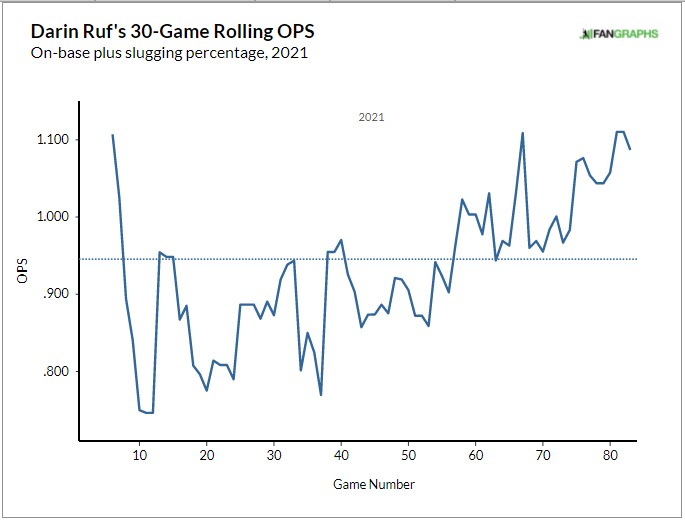I’ll start this article with a cheap trick: In a vacuum, which of the following outfielders have had the best season so far (min. 200 PA)?
As usual, this baseball question merits an “it depends” kind of answer. It depends on if we are looking for the best “real baseball player” or the best fantasy baseball player, and if that’s the case, for which kind of league? That’s why these pick-a-statline questions are so tricky and lend themselves to cherry-picking.
But playing along, we could choose Player A as it looks like he has been on a roll during the number of PAs he’s had this year; his ratio stats are clearly superior and the counting ones (R, HR, RBI) are a reflection of the diminished playing time, compared to the others, nevertheless still managing to outscore them in fWAR.
That player is, of course, Darin Ruf. The rest are Anthony Santander, Victor Robles, Mike Yastrzemski, and Hunter Renfroe, as players B, C, D, and E, respectively. All of them are rostered on way more teams in NFBC competitions than Ruf. The roster percentages are similar for Yahoo! and ESPN leagues, which is a clear call to attention as it looks like a market inefficiency, even at those diminished numbers of plate appearances.
First Chance
Ruf is a 35-year-old veteran, picked in Round 20 of the 2009 June Amateur Draft by the Phillies. He made his MLB debut in 2012 but didn’t make an impression during the five seasons he spent with Philadelphia, accumulating a measly 0.4 fWAR in that timeframe.
At the end of 2016, Ruf was traded to the Dodgers in the deal that briefly took Howie Kendrick to Philly before ending his career with the Nationals, but Ruf was released by the Dodgers before the start of the season.
Aged 30, the once-lauded first-baseman hopeful, who should’ve battled Ryan Howard for the daily job, faced the uncertainty of not having an MLB team, so he set his sights eastward and joined the Samsung Lions in the Korean pro baseball league, the KBO. Then things began to change for him.
A Second Wind
Ruf signed with the Lions and from the first moment, he started to produce, hitting a homer in his first game in Korea. The rest of the year, he hit 30 more for a nice total of 31, good enough for sixth among all qualified batters that season.
Ruf played three seasons in Korea, until 2019, and was one of the main stars of the team, although they did not enjoy too much postseason success.
His numbers during those years were:
Clearly, Ruf found his mojo and got to show the kind of batter he could be. Also, as we can see in the following video, it looks like he and his family enjoyed their time there, too.
Third Act
2020, the pandemic year, was also the year for Ruf to get back to MLB, this time with San Francisco via a minor league deal.
In a limited role, just 100 plate appearances, Ruf batted a respectable .276/.370/.517, with a .379 wOBA and a 140 wRC+, all career highs in MLB for him (min. 80 PA per season).
On his return to MLB, two things must’ve caught the attention of the Giants front office, after the 2020 season: first, improved plate discipline, and second, a slight but important power surge.
As we saw before, in his first MLB stint with Phillies, Ruf struck out at an almost 28% rate (K%) while only sporting an 8.2 BB%. Back from Korea, he finished 2020 with a significantly better K% of 23% and his BB% jumped to 13%.
On the power side, last season he continued with his improved HR pace, keeping it at one homer per 20 PA as in Korea, 30% better than before (one every 28 PA). In this regard, he also got a higher Max Exit Velocity, 111.7 mph, than his previous max since 2015, 110.8 mph, when we started getting data for that.
All that made Ruf a must-have for Farhan Zaidi in 2021, so he continued with Giants and the results have been impressive, even with limited playing time so far.
What could have been producing these changes? Well, while it’s not usually easy to point to obvious behaviors or circumstances that produce better results, but there is a curious difference in Ruf’s batting mechanics that might be part of the reason.
In the following GIF, you can clearly see a difference in where do his hands start: on the left side there is a September 2016 video capture, from when Ruf still played with the Phillies, and on the left another one from his time in Korea, in August of 2017.
https://gfycat.com/dismalsillyarthropods
In Korea, Ruf’s hands started lower than before, a small change that doesn’t explain it all by itself but surely has a significant impact on his swings. In the following image, we can also see that this change stuck for this season, comparing the same stance from September 2016 on the left, with one from this past August, 1st this 2021 season:

The difference here is even more noticeable because his hands are in an even lower position than in Korea, which was already lower than before, and that could be helping Ruf to hit with more power.
Ruf is batting .273/.389/.557, with a .399 wOBA, a 153 wRC+, and a 1.9 fWAR, while mostly subbing for Brandon Belt in first base and some action in the outfield.
In a crowded San Francisco roster, Ruf’s performance has pushed manager Gabe Kapler to find playing time for him, and honestly, look at his 30-game rolling OPS and try to find a reason not to have him in the lineup every day:

In our PL+ Discord, Kyle Horton suggested that someone should’ve taken a look at what Ruf was doing, I decided to do it as about a month ago while doing a mid-season check on Q, a stat that combines hard-hitting with bat control, I suggested the name of Ruf, among others like Paul Goldshmidt, Tyler O’Neill, and Rowdy Tellez, as players to have present for the rest of the year.
Since that day this is how Ruf compares to July’s National League Player of the Month, Freddie Freeman:
It’s safe to say that Ruf’s production has been limited due to lack of plate appearances, producing the differences in the counting stats like runs and RBI, but clearly, Ruf has taken advantage of every single chance he’s had to bat this season. In fact, he has done it so well that he is 11th in the NL in fWAR per Plate Appearances (fWAR/PA), in a list that includes players like Fernando Tatis Jr. and Bryce Harper (min 210 PA):
Let’s be honest, I am aware these are mostly descriptive aspects (although Q can help to predict some future performance), and small samples might fool us more than not. But I’m pretty sure the decision-makers in San Francisco are even more aware of what Ruf is doing than me, and they will make the most out of it the rest of the season.
With the Giants leading comfortably their way into the postseason, Kapler can do a lot of load management the following weeks, giving Ruf more chances to continue batting, I’m pretty sure he will do that so Ruf will continue to be a nice cheap source of good ratios and stats for our fantasy baseball endeavors; his value is especially important in deep daily leagues where you can adjust accordingly to whether he gets the nod that day or not.
A line of .265/.380/.550 with a .390 wOBA and a 155 wRC+ for the rest of the way is very plausible.
KBO stats from https://mykbostats.com/
Photo by John McCoy/Icon Sportswire | Design by Michael Packard (@designsbypack on Twitter @ IG)

